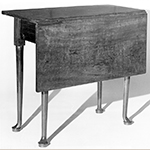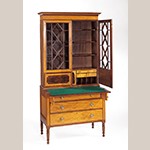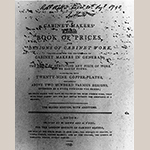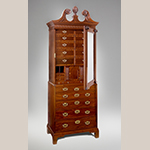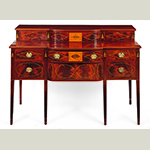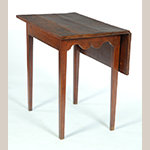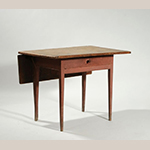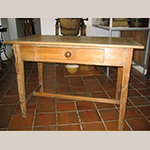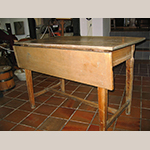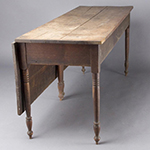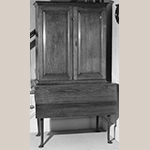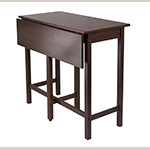Simple curiosity drove this research note on Scottish bedroom tables. Although I did not realize it at the time, I first encountered a bedroom table during my study of the Scottish immigrant joiner John Shearer.[1] I first learned of Shearer’s single-leaf table (Figure 1) during Robert Leath’s talk at the international conference Transatlantic Craftsmanship: Scotland and the Americas in the Eighteenth and Nineteenth Centuries held at the Philadelphia Museum of Art and Winterthur Museum in October 2009.[2] At that conference, Scottish furniture historian David Jones gave the lecture “Scottish High-Style Furniture: The Key Types, 1750-1850,” which included a discussion of the bedroom table form.[3]
A Scottish bedroom table (Figure 2) is a single-leaf table with the leaf, or “flap,” hanging down the back of the table, most often with a drawer on the front rail but sometimes on the end rails (Figure 3). It was intended as a multi-functional table that could be easily stored against a wall when not in use. A card table also has a single leaf, but a card table’s leaf folds up to close over the fixed top, unlike a bedroom table leaf that hangs down when not in use (a card table from Charleston, South Carolina, is presented in Figure 4). A Pembroke or breakfast table serves a similar moveable, multi-purpose role and also often features a drawer; however, it is differentiated by its two leaves that hang from the table’s sides, not its back (Figure 5 illustrates a Pembroke or breakfast table made in Annapolis, Maryland). The one-leaf dining table form can often look quite similar to a bedroom table, especially if the dining table has a square or rectangular top (a British example is shown in Figure 6). But one-leaf dining tables were intended to be part of a set that can be joined together when needed and will frequently have shallow mortise and tenons or other hardware on the leaf edges that help connect multiple tables.
Now able to recognize a Scottish bedroom table and identify what makes it a unique table form, I wanted to know more. My initial goal was to establish how and when the bedroom table form migrated with immigrant Scottish cabinetmakers, such as John Shearer, to the American South. To do so would require a deeper understanding of how this particular table form came into usage in eighteenth century Scotland. As I would discover, however, the origins and even the terminology of the bedroom table are complex and difficult to identify.
Why would I think that there would be more than a few Scottish bedroom tables made and used in the early American South? The John Shearer example was an obvious clue. The Shearer table was made in backcountry Virginia in 1798, some forty years after versions of the bedroom table first began to appear in Scotland. Even more significant are the many documented links between Scotland and communities and craftsmen throughout the South. For instance, there are the strong connections between Scottish merchants and Virginia planters before the Revolutionary War, as outlined in the work of Anne Smart Martin amongst others.[4] Portsmouth and Norfolk, Virginia, both had large populations of Scots by 1765.[5] Also, Charleston, South Carolina, had a large Scottish population, especially members of the cabinetmaking trade. All of those factors led me to expect to find that bedroom tables were made and used in the South, possibly in greater numbers than elsewhere in America.
As my research progressed, I learned that many of my assumptions were incorrect. As I’ve already admitted, the origins and evolution of the bedroom table form proved to be more obscure than expected. And I was surprised to learn that, while bedroom tables were made and used in the South in the late-eighteenth and early-nineteenth century —and examples will be presented and discussed herein—the form seemed to have been more popular in the North, particularly in Massachusetts. Thus, this research note is quite open ended—an exploration of the bedroom table form’s origins and its dissemination to America that leads to more questions than conclusions.
It is hoped that more information will come to light through publication of the research gathered thus far. At the very least, it is hoped that this research note will enable scholars and collectors to recognize the bedroom table as a unique furniture form with a complex and sometimes elusive history that stretches from the Continent to Scotland through England to the New World, including the early American South.
Terminology and Usage
What exactly did the words “bedroom table” mean in the eighteenth- and early-nineteenth century? And how where the tables used? Terminology is always a challenge when researching the nomenclature of furniture. It is particularly challenging when trying to pinpoint a form such as the bedroom table, which was being made in Scotland as early as the 1730s but was not defined in any price book—English, Scottish, or American—until the second decade of the nineteenth century.[6] Adding to a researcher’s confusion, terminology is often used in probate or other inventories that does not appear in price books. That said, attempting to unravel the issue of terminology and usage is important to understanding the Scottish bedroom table.
The first price book to include the term “bedroom table” was the 1811 Edinburgh Book of Prices of Manufacturing Cabinet-Work (Figure 7).[7] The book defined a bedroom table as having a single leaf, or a “flap,” hung with a rule joint (see Fig. 2). It measured two feet, three inches long by two feet, ten inches wide when open. When closed, the leaf hung down one side of the table rather than swinging over the top like a card or game table. Importantly, the standard configuration included a cock-beaded drawer in the front rail.[8] Unlike the legs on the table seen in Fig. 2, the 1811 Edinburgh Book of Prices defined the legs as “plain tapered” and “all solid.”
How was a bedroom table used? The only indication given by the Edinburgh Book of Prices for the form’s usage is in its name: a “table” for a “bedroom.” In all likelihood, the bedroom table evolved from an earlier table form to address the functions of the eighteenth-century Scottish country house apartment, which usually consisted of a bed chamber and dressing room.[9] In order to be practical in a small chamber or room, the bedroom table was designed to take up as little space as possible when stored against a wall yet still be multi-functional. Because bedroom tables were often made with a drawer on the rail opposite the leaf—and the table would have been stored with the leaf against the wall—the drawer would always be accessible for the storage of small books or the retrieval of pens, paper, and other accoutrements for writing.[10] When pulled out into the room, the table could be used for tea, light meals, writing, or playing cards.
The earliest examples of the bedroom table appeared in Scotland circa 1730 and probably originated in Edinburgh.[11] At least two early eighteenth-century bedroom tables survive today: one in a private collection and one at Newhailes, a late-seventeenth-century country house in Musselburgh, near Edinburgh. Later bedroom tables also survive in Scottish country houses, such as Drum Castle in Aberdeenshire; Dumfries House in Ayrshire; Hopetoun House near Edinburgh; The House of the Binns in Linlithgow, Edinburgh; and Paxton House near Berwick-upon-Tweed.[12]
Dumfries House provides the best evidence for how bedroom tables were used in the eighteenth century (Figure 8). Dumfries House was constructed between 1754 and 1760 for the Fifth Earl of Dumfries and is the earliest, and some consider it the finest, architectural commission of the brothers John, Robert, and James Adam.[13] Perhaps more important than the aesthetic accomplishment of the Adam brothers, Dumfries House possesses the original receipts for the furniture purchased for the house by the Earl as well as a 1795 inventory of the household. Together, the receipts and inventory provide a remarkable foundation for understanding how Dumfries House was furnished between 1760 and 1795, making it one of the most important country houses in Scotland today.[14]
Dumfries House is also well-known among furniture historians for having the only fully documented furniture made by London cabinetmaker Thomas Chippendale. The Earl’s original plan was to buy a few pieces of furniture from Chippendale and have his local Scottish cabinetmaker—Alexander Peter—copy the London pieces to fill the house.[15] In this way, the Earl could have “status” furniture but at far less cost.[16] Upon visiting Chippendale’s showroom, however, the Earl changed his mind and had the London cabinetmaker provide most of the status furniture.[17] Alexander Peter still received commissions from the Earl. After all, Peter was not an unsophisticated, provincial cabinetmaker—he is considered one of the greatest of Edinburgh’s cabinetmakers.[18] The Earl had Peter supply some status pieces for Dumfries House to augment the furniture made by Chippendale.[19]
Most crucial to a study of bedroom tables, Alexander Peter also provided utility furniture for Dumfries House servants and other pieces that English furniture historian Christopher Gilbert referred to as “routine bedroom furniture.”[20] The routine bedroom furniture included the very practical bedroom tables. Peter’s 1758 invoice for Dumfries House labeled four of the bedroom tables he made as “4 sq Mahogany tables 1 leaf & lock’d drawer” (in the eighteenth century, craftsmen used the term “square” to refer to the shape of the corners of a table rather than the shape of its top).[21] Ultimately, Peter made nine bedroom tables for Dumfries House.[22]
Despite the noteworthy documentation for the furnishings of Dumfries House, there is some difficulty in understanding exactly how Peter’s nine bedroom tables were used and where they were placed in the house.[23] The earliest surviving inventory for Dumfries House was taken in May 1795, after the Sixth Earl of Dumfries and his family had been using the house for twenty-seven years.[24] The inventory would seem to reflect the house as it was used by the Sixth Earl and his family, not his father, the Fifth Earl, who had commissioned the bedroom tables. Did those nine bedroom tables remain in the same rooms where the Fifth Earl had initially placed them? The Sixth Earl had made a few changes to the house’s furnishings, but he was much more focused on running the estate than redecorating. When he did make changes to the house, in 1784, those alterations were to the Dining Room and a Drawing Room.[25] Thus it might be possible to assume that, in 1795 when the inventory was taken, the bedroom tables could have remained in the same rooms that the Fifth Earl had placed them. If so, where were those bedroom tables?
The 1795 inventory indicated that eight of the nine bedroom tables were used in the four main apartments on the second floor, called the “Lodgeing or Attick Story” in a 1754 drawing by the Adam brothers of Dumfries House (Figure 9).[26] The Blue Silk Damask Room, or Best Bedroom, had two bedroom tables.[27] This room also contained the magnificent mahogany four-post bed with blue silk damask hangings supplied by Chippendale to the Fifth Earl on 26 May 1759.[28] Other bed chambers and rooms on the Attick Story that contained bedroom tables included the North Centre Room (1), the Crimson Room (1), the Chintz Room (1), the Chintz Dressing Room (1), the South Centre Room (1) and on the southwest corner of the main block of the house, the Nursery (1).
The ninth bedroom table was located in the Parlor on the principal floor (Figure 10).[29] The Parlor was the main family living room in the Fifth Earl’s time. In 1795, it retained its name but was furnished and used as a dining room for the Sixth Earl and his family.[30] The Parlor was located between the Family Bed Chamber and the Earl’s Dressing Room, which was used as a private business room or office.[31] It seems that the Dumfries House bedroom tables were found in the guest bed chambers but not the Family Bed Chamber. The Fifth Earl would probably not have needed either a bedroom table or a mahogany writing table in his apartments because he had both the Parlor and an office to entertain guests or discuss business.[32] When the Parlor was furnished as a dining room in 1784, the bedroom table, especially if it were one of the tables without a drawer, could have served as a small additional dining table or as a serving table.[33]
The 1795 inventory takers referred to the bedroom tables in Dumfries House as “fly tables.” The Oxford English Dictionary defines a fly table as “a table with flaps that may be let down” and cites usage of the term in 1785; however, the 1768 inventory for the house of Sir Lawrence Dundas at 19 Arlington Street in London lists “2-flap” tables, a “1-flap” dining table, as well as separately listing fly tables (with no “flaps” or leaves)—suggesting that a fly table does not necessarily have leaves; if it did, the inventory taker would probably have specified the number of leaves.[34] In addition, the 1768-1769 inventory for the Earl of Kerry lists both fly tables and Pembroke or breakfast tables, implying that fly tables and Pembroke or breakfast tables were not interchangeable terms.[35]
The term “fly table” does not appear in the earliest printed English price book, The Cabinet-Maker’s London Book of Prices, and Designs of Cabinet Work (also known as The London Cabinet Book of Prices), published in 1788, nor does the term appear in any of the book’s revisions. A 1770 drawing of a fly table survives from the Gillow furniture manufactory. The table measured 24” x 15” x 2” with no leaves and cross stretchers between the legs.[36] “Fly table” does appear in both the 1805 Edinburgh Book of Prices and the 1811 Edinburgh Book of Prices. In both Scottish price books, the table does not have leaves. In America, on 9 December 1773, the Newport, Rhode Island, joiner John Goddard charged James Atkinson for a mahogany “Fly tea table.”[37] This table and many others of that name from Newport look like tilt-top tea tables. The tops of the table tilt but there are no leaves.
What were the Dumfries House inventory takers describing when they recorded a “fly table” in 1795? It would seem that a fly table did not imply a table with a leaf since price books and known examples of such tables do not have leaves. English furniture historian Adam Bowett suggested that the English definition of fly table really meant a light and moveable table. The term may have come from the “flying coach,” an eighteenth-century English stage coach, so named because of its lightness over roads and its speed at arriving at a destination (as compared to older model coaches).[38] Such coaches would have been at least in the subconscious of the public. With the development of better roads and better coaches, “polite” people became more mobile and could easily move between London, spas and country houses.[39] Thus the use of “fly table” by the Dumfries House inventory takers could have been a hold-over of the idea of a moveable table. Certainly a mahogany bedroom table would not have been light but it could have been moved into a room upon occasion.
Scottish Origins
Where did the bedroom table come from? As interesting as it may be to consider the antecedents for bedroom table terminology in price books and delve into the Dumfries House records to delineate how the tables may have been used, how does such information aid in our understanding of the form’s origin? Is it even Scottish? In the past, the Scots themselves might have been quick to say the origins of the bedroom table were English. But English historian Francis Bamford would have disagreed.[40] He wrote that it is:
…a sad fact that, despite the determined insistence by so many Scots upon the glories and achievements of their nation’s past… lamentably few have been prepared to do anything to preserve the outward and visible signs of their forebears’ genius and abilities… All this is part and parcel of the deeply rooted and too widely held belief among Scottish people that they possess nothing, except possibly whisky, which cannot be bettered among the English.[41]
A previous lack of belief in their own furniture creations aside, the fact that bedroom tables were not listed in any English price books before the form appeared in the 1811 The Edinburgh Book of Prices suggests that the bedroom table originated in eighteenth-century Scotland, not England.[42]
Intriguingly, the closest connection to a possible English date of manufacture is still after Alexander Peter’s 1758 invoice to the Fifth Earl. The furniture manufacturer Gillow, based in Lancaster, England, was one of the most important furnishers to country houses in England and, importantly, also in Scotland.[43] Their Scottish customers typically lived in Glasgow or south-west Scotland.[44] Shortly before Gillow established a branch in London in 1769, they produced a design in 1766 for a “small table,” a single-leaf mahogany table with term legs made by their craftsman William Lupton.[45] The table, with its narrow frame and single leaf, bears a strong resemblance to a bedroom table although not one that looked like Peter’s table with the drawer opposite the leaf (see Fig. 2). Rather it is more like Fig. 3 with a drawer on its end rail.
Alexander Peter was one of Gillow’s major competitors in Scotland, and the firm was probably quite aware of Peter’s work and the easily stored, multi-functional bedroom tables that he made for country houses like Dumfries House (also located in south-west Scotland, even though Peter himself was based in Edinburgh). It would seem a strong possibility that Gillow used Peter’s or another Scottish cabinetmaker’s bedroom table as a source for the design of their “small table.”[46] However, Thomas Chippendale, Thomas Sheraton, and George Hepplewhite published their design books with plans for Pembroke or breakfast tables, so they became much more influential than furniture manufacturers such as Gillow, which did not publish their designs.[47] As a result, the double-leaf Pembroke or breakfast table became more popular with the prosperous classes instead of the practical single-leaf bedroom table that was never published in an English design book.[48]
In the Fifth Earl of Dumfries’s eyes, Pembroke or breakfast tables were status furniture. He had three Pembroke or breakfast tables in Dumfries House, one of which was in the principal dining room, according to the 1795 inventory.[49] This dining room had been converted to a second Drawing Room in 1784 by the Sixth Earl of Dumfries and was used for the public entertainment of guests. While serving essentially the same purpose as the Pembroke or breakfast table, the bedroom tables were relegated to the private or semi-private apartment spaces, still useful but deemed less fashionable.
Twenty years after Gillow designed their “small table,” The London Cabinet Book of Prices, published in 1788, was advertised in the August 1787 Edinburgh Evening Courant, probably because Edinburgh was the center of Scotland’s furniture trade at the time. While the London price book acquainted Scottish cabinetmakers with London furniture and pricing, it failed to address local Scottish furniture forms, including bedroom tables.[50] In 1805, The Edinburgh Book of Prices for Manufacturing Cabinet-Work was published by Alex Smith to address the local Scottish furniture needs not met by the 1788 London price book.[51] As previously discussed, the bedroom table form was not defined in the 1805 Edinburgh Book of Prices, only in the 1811 version published by J. Pillans & Sons. As reason for its publication, the preface to the 1811 Edinburgh Book of Prices indicated that:
…the former book is very deficient, particularly with regard to the inequality of prices, the very limited and ambiguous manner in which the different pieces of work are made out, and an almost total want of the many modern fashions of cabinet-furniture which at present prevail.[52]
Although the bedroom table was not a modern fashion, having first been made and used in the 1730s, there must have been a continuing demand for the table in Scotland causing journeyman to worry they were not getting paid fairly to make them.[53] Once that situation arose, the bedroom table was added to the 1811 price book.
Taken in total, the evidence seems to support that the bedroom table is indeed Scottish—at least in the form that was presented in the 1811 Edinburgh Book of Prices. The table form first began to appear in country houses with the great rebuilding of Scotland in the 1730s. It was a table design apparently offered in the 1760s by Gillow, a firm originally located on the English border with Scotland and heavily patronized by customers in Glasgow and south-west Scotland. The form was omitted in the 1788 London Cabinet Book of Prices and the 1805 Edinburgh Book of Prices but made its first published appearance in the 1811 Edinburgh Book of Prices, which addressed deficiencies in the 1805 versions in regard to “cabinet-furniture which at present prevail.” And finally, the bedroom table is not found in English country houses nor can it be identified in any early eighteenth century English probate inventories examined so far.
Sixteenth- and Seventeenth-Century Antecedents
Could the Scottish bedroom table have been inspired by seventeenth-century or even sixteenth-century antecedents? Tables, after all, did not spring fully formed in the country houses of Scotland’s elite. Might there have be an earlier influence from England that gave rise to the bedroom table? Or even from the Continent?
In his book When Oak Was New: English Furniture & Daily Life, 1530-1700, John Fiske described a form known as a “credence table,” also known as “folding” tables in the late sixteenth century, and cited it as one of the earliest tables developed for opening into large surfaces for dining, reading, or writing, and then folded into smaller surfaces for storage (Figure 11).[54] On most credence tables, but not all, the single leaf folds over the stationary top rather than hanging down the back like on a bedroom table. While credence tables are not narrow rectangular forms like the bedroom table, the idea of an expanding table, regardless of whether the table leaf folds over or hangs down, is certainly comparable. By the late-seventeenth-century, the gate-leg table, called “table with falling leaves” in the period, was developed. These tables were lighter in appearance than credence tables, and had a long narrow top along with two long leaves (usually) that “fell” or hung down rather than folding over.[55]
Fiske also illustrated in his book an example of an early lady’s writing table, basically a narrow, rectangular single-leaf gate-leg table (Figure 12).[56] This table form, with its deep single leaf and narrow rectangular top bears a strong resemblance to the Scottish bedroom table form. The turnings on the table legs bear closer inspection. The vase-on-vase turning sequence, according to curator and turned-chair expert Dale Couch, is a predominantly Continental turning sequence.[57] American Furniture editor and scholar Luke Beckerdite discussed a similar view of vase-on-vase turning sequences in his article on the Huguenot experience in South Carolina.[58] Beckerdite was careful to point out that Huguenot elements do not automatically equate to furniture made or influenced by the French because the Huguenots introduced a variety of northern European decorative details in their work. Furniture historian Adam Bowett would agree with Beckerdite’s assessment to not automatically connect Huguenot with French influence. In his book, English Furniture, 1660-1714, Bowett discussed how not all French immigrant craftsmen to England were Huguenots and that the Dutch also made a contribution to English decorative arts after 1660.[59]
Another rare surviving example of an early single-leaf gate-leg table that speaks with a Continental accent was illustrated by Fiske, one that he wrote is typical of the Lake District of England (Figure 13).[60] The Lake District is located in north-west England, near the border with Scotland. Perhaps the Continental influence seen in this table is an extension of the Scots political and cultural alliance with France, which was Scotland’s most important connection with the outside world between the fourteenth and sixteenth centuries.[61] Or perhaps it reflects the Flemish weavers who first settled in northwest England in the fourteenth century. Because of persecution in the second half of the seventeenth century, more came to the area, creating a cotton-spinning and weaving production center for which Bolton, in Greater Manchester, became well-known.[62]
Peter Thornton credited the French, in particular the Marquise de Rambouillet (1588-1665), for being the first to place more focus on “convenience, ease and comfort” in private apartments.[63] An easy-to-move table with a folding leaf would have served Frenchwomen well because they used their apartments not just for dressing, but also to entertain their friends or as private space for reading, reflection, and writing. Fiske discussed the concept of the writing table being a feminine form, while the desk or scrutoire was a masculine form, designated for business because of its ability to store important papers.[64] Could the feminine domain of the writing table versus the masculine preference for a desk provide a clue to the bedroom table’s French origins? As will be discussed later in this article, moving into the late-nineteenth and twentieth century, the bedroom table was found most often in the parlor and kitchen in America, both rooms firmly within the female sphere of influence.
It may not be possible to make any firm conclusions about where and when the need arose for a practical single-leaf form such as the bedroom table. The influences are varied and layered. More research, however, is warranted into the evolution of tables in the sixteenth and seventeenth centuries—both in England and on the Continent—to find possible antecedents of the Scottish bedroom table.
Trans-Atlantic Transference
How popular was the bedroom table form in America between 1740 and 1815?[65] In what regions did they appear with more frequency? When examining American probate inventories, bedrooms tables should be looked for in three rooms: the bed chamber, parlor, and dining room. Those are the rooms in American houses that best correspond to the location of bedroom tables in Scottish country houses.[66]
Surprisingly, the term “bedroom table” does not appear to have been used in American inventories.[67] In all, three single-leaf tables were listed in the Maryland and Virginia probate inventories in the Gunston Hall database, making them an uncommon form in the South. Could those single-leaf tables actually be bedroom tables in the form defined by the 1811 Edinburgh Book of Prices? A one-leaf table could just as easily have been a corner table (a three-sided table with the leaf hinged across the long side) or part of a dining table set.
The 1736 inventory of the estate of Pennsylvania Governor Patrick Gordon recorded “a Walnut one leafd Table.”[68] The earliest-known bedroom tables in Scotland date to the 1730s, so a Pennsylvania bedroom table made in 1736 would indeed be a very early, although not impossible, example of the form. Without more information about the dimensions of Governor Gordon’s table, it is impossible to know for sure if it was a proper bedroom table.
On occasion, inventory takers did use the term “one-leaf table,” such as in the 1777 inventory of John Dalton of Fairfax, Virginia, who had a “1 leav’d Walnut Table 40/ 2. 0. 0.” Perhaps Dalton’s one-leaf table was of a nicer wood or newer style than his two-leaf table, which was valued at half the price, ‘20/ 1. 0. 0.’[69] Unfortunately, items in his inventory are not listed by room, so it is unclear where the “1 leav’d Walnut Table” was placed.
John Dalton’s inventory indicated that he had sixteen tables. Besides the “4 Mahogany Dressing tables and Glass,” he also had a tea table, a four-foot folding table, an oval table, the one- and two-leaf walnut tables already mentioned, an oval walnut table, a square table, an old table, and four square pine tables. The dressing tables were probably used in the bed chambers. The pine tables, being of less desirable wood and listed with cooking equipment such as “1 Large Copper Kettle” and “1 Frying Pan,” were used in the kitchen. What was the folding table? Was it a small gate-leg table?[70] The remaining tables, including the “1 leav’d Walnut Table” could have been configured with another table depending upon the need. For example, in April 1786, Gillow depicted a dining table created from joining a card table and a two-leaf dining table to make one large table.[71] Unfortunately, there is not enough information to determine if the “1 leav’d Walnut Table” was of the bedroom table form; it could have been part of a dining table set.
Large dining tables were often made in pairs (or more) that could be joined together to form one large table as needed. When a pair was not being used together, the set could be split and each individual table used as a pier table. Such individual dining tables may have looked similar to a bedroom table with one leaf hanging down, especially if the table had a square or rectangular top. The depth of the table bed is not always helpful in determining if a table was a bedroom table or part of a dining set because sizes varied among bedroom tables. Details on the leaf edges, however, are more useful: tables that belong to a dining set will often have shallow mortise and tenons or other hardware on the squared leaf edges that help connect the two opposing leaf edges and prevent them from separating during usage. Bedroom tables often have a shaped leaf edge.
George Washington ordered a pair of dining tables through his English agent, making it clear that the tables had to match so that they could be joined together to form one large table when necessary.[72] In 1770, Jonathan Bowman of Boston ordered two drop leaf tables from local cabinetmaker George Bright of Boston, for his dining room.[73] Bright also made a bedroom table for the Faulkner family of Acton, Massachusetts (Figure 14).[74] Although the squared edge of the leaf might suggest this table was part of a dining table pair, the narrow fixed top of 16-1/2 inches and the lack of shallow mortise and tenons or other hardware on the leaf edges suggest instead that it was a bedroom table. Because this table lacks a drawer, it could have been used in the dining room as a serving table or in a parlor as a multi-functional table.
Moving beyond the historical record, a survey was conducted to identify the known circa 1740-1815 American-made tables that relate to the bedroom table form. The tables identified reside in museums, select private collections, and some have appeared on the market.[75] A total of thirty-five American-made tables that relate to the bedroom table form were found. Of those thirty-five tables, twenty-one are from New England, three from Pennsylvania, two from New York, five from Virginia or North Carolina, and four from South Carolina. While certainly not a scientific survey, the numbers reveal that most were made in New England, and Massachusetts in particular. The New England tables (Figures 14, 15, 16, and 17) have shaped aprons on front and end rails, and often feature well-articulated cabriole legs with pad on disk or claw and ball feet.
The number of surviving tables made in New England that relate to the bedroom table design may be surprising to those more familiar with the large Scottish settlements in the American South—particularly Virginia, Maryland, and North and South Carolina. It is important to recognize that by the end of the eighteenth century there were approximately 17,000 Scots in northern New England. Those Scottish New Englanders often owned “facsimile forms” or furniture that copied the status items from Scotland, meant as “domestic show furniture.”[76] While the bedroom table was not a status piece of furniture in Scotland—remembering that the Fifth Earl of Dumfries had the local Scottish cabinetmaker Alexander Peter make his bedroom tables and not the London shop of Thomas Chippendale—could bedroom tables have been one of the facsimile forms valued for their multi-functional practicality by the Scots living in mid-eighteenth-century New England? Possibly, but Scottish heritage does not fully explain the form’s popularity in New England because records indicate that non-Scottish craftsmen in New England made them for non-Scottish clients.
A good example of a non-Scottish craftsman making bedroom tables is Massachusetts cabinetmaker Nathaniel Gould (1734-1781), a third-generation American who worked in Salem, and was probably exposed to Scottish furniture forms through immigrant Scots craftsmen well acquainted with the bedroom table form.[77] According to his shop account books, Gould made twenty-seven “side tables” between 1758 and 1781.[78] Those “side tables” were, in fact, a variation of the Scottish bedroom table. The table in Fig. 17, which is attributed to Gould, illustrates an example of the mahogany ”side tables” that he sold to his wealthy clients in Salem. His clients included members of the Cabot family, one of Salem’s leading families during the mid-eighteenth century.[79] Gould’s prominence as a local cabinetmaker and the twenty-one mahogany bedroom tables or “side tables” that he made over the course of his career for his wealthy Salem clients helped popularize the Scottish bedroom table form, possibly resulting in the abundance of such tables found in Massachusetts and elsewhere in New England. In the end, a reason for the popularity of the bedroom table form in New England may have simply been the adoption of a good idea by influential non-Scottish craftsmen such as Nathaniel Gould.
Gould’s use of the term “side table” in his account books may provide a clue to the tables’ usage, most likely in the parlor or dining room. Like a Pembroke or breakfast table, the “side table” could be moved about the room as needed for dining, card playing, or writing. Gould often made his tables with the rail opposite the leaf of a secondary wood, not mahogany.[80] Traditionally, Scottish bedroom tables employed the primary wood on all four rails (even those without a drawer). For the tables that Gould made with the opposite rail of secondary wood, his intention may have been for the table to remain against a wall or under a window when being used. Against a wall in a room used for dining, the table could be used as a sideboard table. Unlike the sideboard table described in the 1788 edition of The Cabinet-Maker’s London Book of Prices, however, Gould’s table would have a leaf that would provide an additional surface if needed. The idea of a large single-leaf table used in this way can be seen in some Scottish country houses, such as the 10½-foot long table in the dining room of Glamis Castle in Angus, Scotland (Figure 18).[81] Since the sideboards in Glamis Castle’s dining room are primarily used for displaying silver and ceramics, this table’s purpose is to hold dishes about to be served at dinner. Gould’s table could also have been pulled out into the room and covered with a cloth, hiding the secondary wood from view.
Moving south from Massachusetts to Pennsylvania, two of the three Pennsylvania tables discovered in the survey appear to have crossed the cultural lines with heavy Baroque turnings associated with German craftsmen, for example the table illustrated in Figure 19. With its drawer opposite the leaf, the table is exceptionally similar in design to a Scottish bedroom table despite its Germanic design elements. The third table in the survey has cabriole legs and claw-and-ball feet and was more likely made by an English-trained craftsman.
In spite of the small number of surviving examples, southern-made bedroom tables display a wide variety of styles. In 1798, joiner John Shearer, an immigrant from Edinburgh circa 1775, made a large, blocked serpentine-front bedroom table in Martinsburg, Virginia, now West Virginia (see Fig. 1). Typical of the exuberant work of this joiner, Shearer’s table contains one of the loyalist expressions for which he is well known: “Made by Shearer from Edinburgh, July 27th, 1798 / I am a true frind [sic] to my King + country…and tell the Whole World Round Grate [sic] / Gorge [sic] is King Hurah.” With its shaped front, this table clearly would have been stored with the leaf against the wall, despite its lack of a drawer.[82]
A Tidewater, Virginia, bedroom table, circa 1750-1765, has unusual scalloped corners on the top (Figure 20). Although a table without a drawer would normally suggest it was stored leaf side out to the room, the deep overhang and shaped top indicates the opposite. It could have been used as an extra dining table, a writing table, or game table in the parlor. It would have also been an elegant addition to a bed chamber where it might have been used as a dressing or writing table, as well as for serving light meals.
A circa 1750 bedroom table found in Bath, North Carolina, has legs with a canted mid-section, a popular late Rococo design in Great Britain, especially in Ireland (Figure 21).[83] As in America, bedroom tables are found in Irish counties where immigrant Scottish cabinetmaking practices took root.[84] The legs are similar to those shown on a breakfast table in plate 53 of the third edition (1762) of Chippendale’s Gentleman & Cabinet-Maker’s Director.[85] The tassel-like feet are a variant of similar but more formal feet that mimic guttae, or cone-shaped ornaments attached to the underside of mutules (flat projecting blocks) or beneath triglyphs (raised rectangular blocks) in a Doric entablature. Chippendale illustrated a similar foot in plate 21 of the first and second editions of his Director.[86] The legs and feet on this table relate to tables from New Bern, North Carolina, and Norfolk, Virginia.[87] While the maker of the table is unknown and leaves us guessing about the specifics of his training, the table reflects British urban design through its legs and feet and Scottish design in its overall form.
The back rail of the table illustrated in Fig. 21 is made of a poor quality cherry, indicating that the table was primarily kept against a wall. Its lack of a drawer points to its use in the parlor or dining room as a serving table. The feet originally had castors (which are now replaced) so it could have easily been rolled into the center of the room. With the leaf raised and the table covered with a cloth, one would not notice the poor quality wood on the back rail. This table has a swing arm instead of a swing leg to support its leaf.
A city such as Charleston, South Carolina, with its strong eighteenth- and early-nineteenth-century merchant and craftsman connections to Scotland, would be expected to have had a preponderance of bedroom tables in the homes of the elite and middling classes. John Bivins’s and Brad Rauschenberg’s research into the furniture of Charleston uncovered a few single-leaf tables, but not as many as anticipated. Some of those tables may have been part of dining table sets instead of being individual bedroom tables; however, a table at the Charleston Museum’s Heyward-Washington House (Figure 22) looks like it came directly out of a Scottish country house, with only the secondary woods of cypress and red cedar indicating its American origins.[88] During the course of his research, Rauschenberg collected documentary evidence for furniture forms and terminology in Charleston before 1820.[89] When assessing his findings, Rauschenberg surmised that Charlestonians referred to their bedroom tables as “breakfast tables.” Frustratingly, the documentary evidence only refers to “square” or “round” breakfast tables and never by the number of leaves. Without any reference to “single-leaf” breakfast tables in the documents, there is simply no evidence that a Charleston breakfast table was equivalent to the Scottish bedroom table form.
To assume that Charleston would be awash with bedroom tables because the city had a large population of Scots was a leap. The large Scottish enclave of cabinetmakers only came to prominence around the 1790s, although a few were in the city earlier.[90] Importantly, those late-eighteenth-century Scottish cabinetmakers made their living by meeting elite clientele’s needs for status furniture. The elite wanted London-styled status furniture based on published London designs, even if it was made locally.[91] For example, cabinetmaker Robert Walker (b.1772-d.1883), an immigrant from Cupar, Fife, Scotland, who landed in New York City before coming to Charleston in 1795, brought his personal copies of Thomas Sheraton’s 1791 edition of The Cabinet-Maker and Upholsterer’s Drawing Book and the 1793 edition of The Cabinet-Maker’s London Book of Prices to ensure he was making furniture in the latest London taste (Figures 23 and 24).[92]
A few immigrant Scottish cabinetmakers in Charleston did make some status furniture with a specifically Scottish flavor, such as the lady’s closets that appeared in the mid-eighteenth century (Figure 25).[93] Later in the century and into the first decades of the next, stage-top sideboards, a signature high-style Scottish furniture form, appeared in Charleston (Figure 26). Probably influenced by French buffets of the mid-eighteenth century, these sideboards, with their double tops, would have provided more surface for the display of plate and ceramics.[94] But bedroom tables were not status furniture. In Charleston, the popular and multifunctional small table of choice was the Pembroke or breakfast table because, as noted earlier, that form was most popular in England. It is, therefore, likely that nearly all of the breakfast tables listed in Charleston’s probate inventories and at estate auctions were two-leaf Pembroke or breakfast tables and not single-leaf bedroom tables.
A small table found in South Carolina (Figure 27) has the falling single leaf of a bedroom table, but its fixed top is twenty-inches deep, which negates the space-saving quality of most Scottish bedroom tables. Its overall size is more closely related to a Pembroke or breakfast table. Without a drawer to store items, this table was probably not used as a writing or work table, although it could have served those needs or as a small game table when covered in baize. More likely, this vernacular table was used in the parlor or dining room as a small serving table.
Fig. 6 illustrates a single-leaf dining table commonly found in America and probably also made in England in great numbers. This elegant table is close to 4-1/2 feet long with a deep leaf. There are no shallow mortise and tenons or other hardware on its squared leaf edge to suggest it could have been part of a dining set. The deep leaf, however, makes it more likely to be a dining table rather than a sideboard in the bedroom table form; the large leaf would take up too much space as a serving table at the edge of the room.
Both the 1788 and 1793 editions of The Cabinet-Maker’s London Book of Prices specify a standard dining table with one or two leaves. They do not provide an option for a drawer. It would seem that the English preferred their drawers on small tables like the Pembroke or breakfast table. In America, there were small two-leaf dining tables made with drawers. It would appear that, on occasion, American craftsmen followed practicality over slavish attention to a British design ideal. The table shown in Fig. 6 helps to illustrate that not all single-leaf tables were designed to be as multifunctional as bedroom tables and therefore could not be said to represent the form. In a pinch this table could be used against a wall as a serving table in a dining room or parlor, but it would be used best in combination with other tables to form a larger table (despite the lack of connecting hardware on the leaf edge) or when pulled away from the wall with the leaf opened in preparation for setting the table for a meal.
Bedroom Table or Kitchen Table?
Did the walnut or mahogany Scottish bedroom table become a pine American kitchen table? By the time the term “bedroom table” appeared in Scotland, in the 1811 Edinburgh Book of Prices, Americans appear to have relegated the form to more service areas like the kitchen. An example is found in Philadelphia’s 1772 Price of Cabinet and Chair Work, described as a single-leaf pine kitchen table with one leaf hung with a rule joint, four feet long, and one drawer.[95] In 1819, cabinetmaker Nathaniel Dominy V of East Hampton, New York, built a pine table with one leaf, charging Abraham Sherrill Jr. £1-8-0.[96] Twelve other nineteenth-century, single-leaf kitchen tables made from pine—all attributed to New England—were discovered in the survey, including the one illustrated in Figure 28.
Was the pine single-leaf kitchen table an American invention? Neither the 1805 nor the 1811 edition of The Edinburgh Book of Prices included a design for a softwood single-leaf kitchen table with one drawer. That said, as early as the eighteenth century, prosperous Scottish farmhouses in both the highlands and lowlands of Scotland did indeed have single- or double-leaf kitchen tables made from softwood with one or two drawers. In eighteenth-century Scotland, lower-class “cottagers” built their own small homes, and their size precluded the use of a table in the kitchen.[97] By the late-nineteenth and early-twentieth century, their houses grew in size and they also began to use single-leaf kitchen tables.[98]
Considered an essential piece of furniture in Scotland, a scrubbed softwood kitchen table, often made from deal wood or pine (called “fir” in Scotland), was used for “eating, food preparation, working and even for minor surgical operations such as tonsillectomies.”[99] Gillow produced a drawing in May 1793 for a “common deal dining table” which, being made from a softwood, was probably used in the kitchen.[100] Such single-leaf kitchen tables especially made sense in the tight quarters of tenement house kitchens.[101] Single-leaf tables could be found in Scottish kitchens as late as the 1960s, only losing popularity when the preference for built-in kitchen cabinets and counters came into vogue (Figures 29 and 30).
In America by the mid-nineteenth-century, long kitchen tables made of pine or birch and featuring a single leaf were apparently popular in New England (four turned up in the survey). The identified tables are similar to one from Shenandoah or Rockingham County, Virginia (Figure 31). Used in the kitchens of farming communities, the tables would have been placed against a wall until needed for dining, or brought onto back porches where vegetables and other foodstuffs were prepared before bringing the tables back into the kitchen. In the South, similar long kitchen tables have been found from Augusta County, Virginia, north to Frederick, Maryland. Interestingly, most of the tables were found in or near traditionally German settlements, not areas where there were large numbers of Scots.[102] While the length of this table form suggests the influence of dining tables such as the one in Fig. 6, their rather utilitarian (multi-funtional) usage and lack of “status” make them more closely related to bedroom tables.[103]
The table illustrated in Figure 32 looks like a bedroom table although its fixed-top depth of twenty inches, like that of the South Carolina table (Fig. 27), means it lacked the space-saving quality of most Scottish bedroom tables. While it has similar dimensions to the table in Fig. 28, its decorative elements indicate it was probably used in a parlor as a work or writing table, not in the kitchen.
Another use of the single-leaf table in America, according to David Jones, is not a Scottish form at all: There are surviving examples of tables that were used as the base for a cabinet or bookcase, creating a simple desk and bookcase.[104] Three single-leaf tables with attached cabinets or bookcases turned up in the survey, the earliest is a circa 1745-1755 table and bookcase made in central Virginia (Figure 33).
Conclusions
Can any firm conclusions be made about the Scottish bedroom table? Through my research, I learned that the form gained popularity as early as the 1730s in Scottish country house apartments as a multi-purpose table used for dining, entertaining, and work. The form existed for decades before it was recorded in the 1811 Edinburgh Book of Prices. That is about all that can be stated with certainty.
There may be sixteenth- and seventeenth-century antecedents for the bedroom table—perhaps French or Dutch—but to fully identify these will require much more research. For now, the evidence seems to indicate that the bedroom table—at least the form presented in the 1811 price book—is probably a uniquely Scottish form. And, as Scottish emigrants and cabinetmakers spread out to England, Ireland, and the New World, their space-saving bedroom table form migrated with them.
A total of thirty-five surviving American versions of the bedroom table form, made between 1740 and 1815, have been identified. Those tables were made in New England, Pennsylvania, New York, Virginia or North Carolina, and South Carolina. Surprisingly, it seems that it is in New England, primarily North Shore Massachusetts, where the bedroom table proved to be most popular. It was such a functional and practical furniture form that it was sought out and purchased by non-Scottish patrons—and made by cabinetmakers, such as Nathaniel Gould, who had no Scottish heritage.
The American acculturation of the bedroom table continued into the mid nineteenth century, when single-leaf tables made of softwood became commonly used kitchen furniture, both in the North and South and among the Scottish and non-Scottish. The journey of the bedroom table form from the chamber and parlor (in mahogany or walnut) to the kitchen or back porch (in pine or birch) illustrates precisely how the attractive utility of the bedroom table form traversed cultures and time. Even today, one can purchase a single-leaf table on Amazon.com that boasts its versatility as both space-saving and functional (Figure 34).[105]
While not as many bedroom tables as expected were found in the American South, several examples were uncovered. It seems that Scottish immigrants throughout the South in the late eighteenth and early nineteenth century, especially in Charleston, wanted to procure status furniture based on published London designs—the type of furniture purchased by their non-Scottish, southern neighbors. As historian Stephen Jackson wrote in discussing the influence of Scotland in American cabinetmaking: “The relationship between tradition and fashion was always complex and ethnicity was one of many component influences on taste and behavior.”[106]
I had assumed that bedroom tables in America would be discovered predominantly in the South. After all, the joiner John Shearer from Edinburgh made one in backcountry Virginia in 1798. And there were strong communities and networks of Scottish immigrants and craftsmen throughout the South. It was a simplistic outlook from which to begin. Starting a research project with some assumptions may be acceptable, but one must be open to how those assumptions can change. Regardless, the road to discovery is filled with fascination and fulfillment.
Thus far, my exploration of the bedroom table has brought me a greater understanding of Scottish country houses and how a furniture form designed for one purpose can evolve to meet the needs of a much broader audience. More research needs to be done, especially on earlier types of tables that influenced the bedroom table’s development. It is hoped that more examples will come to light by publishing this research note, especially those with strong provenances, as well as any pertinent inventories or other documentation. For now, at least, the Scottish bedroom table can be recognized and appreciated as a unique furniture form.
Betsy Davison is an independent decorative arts historian and author. She can be reached at www.elizabethadavison.com.
The author would like to thank the following people for their assistance with this article: Gary Albert, Adam Bowett, Andrew Brunk, Debbie Bender, Katherine Chabla, Tara Gleason Chicirda, Susan Conway, Bill Cotton, Dale Couch, Mack Cox, Brandy Culp, Diane Dunkley, Adrienne Donohue, Peter Eaton, Jeff Evans, Oscar Fitzgerald, Moira Gallagher, Lucy Gilmour, Abby Grissinger, Emily Gutherie, Liz Hancock, Winifred Harley, Hamish Howe, Charlie Hummel, Ron Hurst, Christa Johnson, Chris Jones, David Jones, Alexandra Alevizatos Kirtley, Ned Lazar, Robert Leath, Gordon Lohr, Grahame Long, Hilary Macartney, Diedre Pook Magarelli, Dick Mattingley, Mark McLean, Jim Melchor, Tom Newbern, Bert Parsons, Sumpter Priddy III, Nicholas Powers, Brad Rauschenberg, Charlotte Rostek, Peter Sawyer, David Schorsch, Monica Scott, Tom Sears, Patrick Sheary, John Snyder, Liz Stanford, Thea Stevens, Robert Trent, Betsy Garrett Widmer, Kem Widmer, David Williams, Kathy Woodrell, and Phil Zea.
[1] Elizabeth A. Davison, The Furniture of John Shearer, 1790-1820: “A True North Britain” in the Southern Backcountry (Lanham, MD: AltaMira, 2011).
[2] Robert Leath identified the connection between the John Shearer single-leaf table and the Scottish bedroom table form in his lecture “Thistles and Pineapples: Scottish Furniture Makers in the Early South” presented at the Transatlantic Craftsmanship conference.
[3] David Jones has been extremely helpful to my understanding of the Scottish bedroom table and its use in Scotland, both at the conference, via email and during my visit to Scotland. His lecture, along with several others from the conference, was published in Vanessa Habib, Jim Gray, and Sheila Forbes, eds., Making for America: Transatlantic Craftsmanship: Scotland and the Americas in the Eighteenth and Nineteenth Centuries (Edinburgh: Society of Antiquaries of Scotland, 2013).
[4] Ann Smart Martin has written extensively about the connection between Glasgow merchants and the Virginia tobacco trade in Buying into the World of Goods: Early Consumers in Backcountry Virginia (Baltimore, MD: Johns Hopkins University, 2008) and “Scottish merchants; sorting out the world of goods in early America,” in Habib, et al., Making for America, 23-44.
[5] Norfolk was the largest and most important port on the lower Chesapeake Bay before it burned (David Dobson, Scottish Emigration to Colonial America, 1607-1785 [Athens: University of Georgia, 2004], 100). Because most of Norfolk’s buildings and their contents burned, it is not known if bedroom tables were made in that city but an intriguing possibility appeared on the market. Although missing a leaf, the rule joint on a table that sold at Leland Little Auction clearly indicates it began life as a bedroom table because the leaf hung down the back and did not flip over the top like a card table. This table was probably made in Norfolk and has a relationship to the more vernacular bedroom table illustrated in Fig. 21. The feet on the table in Fig. 21 are likely an interpretation of mainstream Norfolk work. [Jim Melchor, email with the author, 11 September, 2014.] Leland Little Auction, lot 948, 13 September 2014, online: https://www.lelandlittle.com/auctions/27.4/948/ (accessed 30 September 2014).
[6] Price books, whether hand-written manuscripts or printed, were intended as agreements between journeymen and masters on the rates or costs in labor for making furniture. As such, they contain useful information by providing the name of furniture forms such as a Pembroke or breakfast table, and defining dimensions and ornamental options. But price books can also be confusing if they are compared to other price books from the same period because not every price book contains the same furniture forms. In addition, price books do not list every piece of furniture a journeyman was capable of making; rather, they listed pieces for which a journeyman wanted to ensure what was considered a fair wage to make. Charles Hummel, conversation with the author, 9 January 2014.
Evidence suggests there were manuscript (hand-written) agreements between journeyman and employers before printed prices books. Sometime around 1784, Robert Gillow of Lancaster, England, had an agreement with his journeymen. In America, the earliest such agreement was the 1756-1757 manuscript Rule and Price of Joyners’ Work for Rhode Island craftsmen. The first printed furniture price book in America or Great Britain is The 1772 Philadelphia Furniture Price Book. See Irving W. Lyon, The Colonial Furniture of New England—A Study of the Domestic Furniture in Use in the Seventeenth and Eighteenth Centuries (New York: E.P. Dutton, 1977); Ralph Fastnedge, Shearer Furniture Designs from the Cabinet-Makers’ London Book of Prices 1788 with a Preface and Descriptive Notes (London: Alec Tiranti, 1962), 1-6; Alexandra Alevizatos Kirtley, The 1772 Philadelphia Furniture Price Book: An Introduction and Guide (Philadelphia, PA: Philadelphia Museum of Art, 2005), 9-12; Charles F. Montgomery, American Furniture: The Federal Period in the Henry Francis du Pont Winterthur Museum (New York: Viking, 1966), 19-20; Martin Eli Weil, “A Cabinetmakers’ Pricebook,” in “American Furniture and Its Makers,” Winterthur Portfolio, vol. 13 (1979), 175-79; Christopher Gilbert, “London and Provincial Books of Prices: Comment and Bibliography,” Furniture History, vol. xviii (1982), 11-15.
[7] The Edinburgh Book of Prices for Manufacturing Cabinet Work (Edinburgh, Scotland: J. Pillans & Sons, 1811), 60. See also, David Jones, The Edinburgh Cabinet and Chair Makers’ Books of Prices, 1805-25 (Cupar, Scotland: Kirk Wynd, 2000), Introduction to 1811 Price Book, 60.
[8] Ibid. The Edinburgh Book of Prices for Manufacturing Cabinet Work was published in 1811 by J. Pillans & Sons. In 1805, a price book of the same name was published by Alexander Smellie, son of the famous Edinburgh publisher William Smellie. To distinguish between the two price books when referring to them in this research note, the publication date will be used before each title.
[9] In some larger country houses, an apartment might include a closet, a much smaller room than either the bed chamber or dressing room. While a bed chamber and dressing room might at times have been used as public space, a closet was a small private space that might be used for study or religious devotion. In some larger country houses, an apartment might include a closet, a much smaller room than either the bed chamber or dressing room. Mark Girouard, Life in the English Country House (New Haven, CT, and London: Yale University, 1978), 206.
[10] In order to write letters or in a diary, the writer required an ink bottle, sand-box, and pens. If writing a letter, sealing-wax, a small candle for heating the wax, and a tinder-box lighting the candle might also be needed. All writing or reading at night, of course, was done by candlelight. Lamps that were safe, practical, and gave better illumination than candles were not available in England until the last quarter of the eighteenth century. John Gloag, Georgian Grace: A Social History of Design from 1660 to 1830 (New York: Macmillan, 1956), 271-4.
Not all drawers on bedroom tables are located on the rail opposite the leaf; some are located on one or both ends (Fig. 3). Drawers on an end would allow the table to be stored with the leaf facing out; however, this would mean the leaf would need to be raised to be used as a work table, making it slightly less efficient than the Alexander Peter model.
[11] David Jones, conversation with the author, 15 July 2013.
[12] David Jones, e-mail with the author 1 December 2011; Liz Hancock, e-mail with the author, 22 August 2013; Robert Leath, e-mails with the author, 8-9 February 2013. The author toured Hopetoun House on 17 July 2013.
[13] Simon Green, Dumfries House (Edinburgh: Royal Commission on the Ancient and Historical Monuments of Scotland, 2014), xi; James Knox, The Scottish Country House (New York: Vendome, 2012), 113; Marcus Binney, Charlotte Rostek, and Sir Hugh Roberts, Dumfries House, The Great Steward of Scotland’s Dumfries House Trust (London: Leighton Printing, 2011), 6; Christie’s London, Dumfries House: A Chippendale Commission, auction catalog, July 2007, vol. I, 7, 11, 12.
[14] Dumfries House survives today with a majority of its original furnishings intact thanks to His Royal Highness The Prince of Wales and a consortium of Scottish charities and heritage bodies who rescued Dumfries House’s contents from a sale at Christie’s in 2007. For more information about the rescue of Dumfries House, see James Reginato, “Restoration Drama,” Architectural Digest, February 2012, 58-69. Christie’s two-volume catalog provides a nearly complete listing of the contents of the house at the time of the sale (Christie’s, Dumfries House, vols. I and II, 12-13). See also, “About Dumfries House,” available online: http://www.dumfries-house.org.uk/about/ (accessed 12 August 2013).
[15] When deciding on furniture, the owner of a newly built Scottish country house had a choice: He could buy his furniture in the style center of London and have it shipped to Scotland or have it made locally. The Fifth Earl of Dumfries did both. Christopher Christie, The British Country House in the Eighteenth Century (Manchester, England, and New York: Manchester University, 2000), 237.
[16] In the eighteenth century, furniture was often purchased to establish a difference in status from lesser classes. Objects such as furniture, carpets, gilt pier glasses, and chandeliers demonstrated good taste and gentility.
[17] This furniture is probably “shop work” rather than “bespoke,” or custom made, because the Earl of Dumfries was able to see the furniture at Chippendale’s London workshop and have it dispatched soon thereafter. Green, Dumfries House, 85; Christies, The British Country House in the Eighteenth Century, 238.
[18] English historian Francis Bamford discussed Alexander Peter as one of three early masters of Scottish furniture: “Just as the names of Chippendale, Hepplewhite and Sheraton dominate in any discussion of English furniture in the eighteenth and early nineteenth centuries by reason of their well-known pattern-books, to the possible ignoring of many well-patronized and excellent craftsmen, so in Scotland the reputations of Alexander Peter, Francis Brodie and William Trotter tend to overshadow, on account of their very individual designs and workmanship, the memory of many fine cabinet-makers.” Francis Bamford, “A Dictionary of Edinburgh Wrights and Furniture Makers 1660-1840” (London: Furniture History Society, 1983), 10-11; Jones, The Edinburgh Cabinet and Chair Makers’ Books of Prices, 5.
[19] Peter supplied furniture such as the mahogany chairs for the entrance hall, a sideboard copied from the first edition (1754) of Chippendale’s Gentleman & Cabinet-Maker’s Director, and twenty-four mahogany dining room chairs. Christopher Gilbert, “Thomas Chippendale at Dumfries House,” The Burlington Magazine, vol. 111, no. 800 (1969), 672, 675; Bamford, “A Dictionary of Edinburgh Wrights…,” 11-15.
[20] Gilbert, “Thomas Chippendale at Dumfries House,” 675.
[21] Bamford, “A Dictionary of Edinburgh Wrights…,” 97; Christie’s, Dumfries House, vol. II, 32-33, no. 169. It should be noted that Dr. Sebastian Pryke wrote that “Peter’s first substantial account for furniture for Dumfries House begins in May 1759… .” This is not contradictory to the existence of Peter’s 1758 invoice because the bedroom tables were not considered status furniture and he does not mention them. Pryke discussed the four-poster beds, mahogany chairs, foot stools, and other pieces that Peter made. Sebastian Pryke, “Furnishing the House 1754-1760,” in Green, Dumfries House, 96.
[22] Five of the nine bedroom tables are attributed to Peter based on the four tables he invoiced the Earl for in 1758. The tables’ dimensions published in the Christie’s catalog reveal that not all them were the same width or had the same size leaf; while most had relatively deep leaves, Peter did make one bedroom table with a leaf three inches shorter than the other tables (Christie’s, Dumfries House, vol. II, 118, no. 249).
[23] Unlike most of his peers, who would have relied on others to supervise his house’s furnishing and furniture placement, the Earl took on the responsibilities himself. Placing the bedroom tables throughout the house would have been entirely at the Earl’s discretion and possibly his whimsy. He was without the aid of his first wife, who died in 1755. John Adam gave him some advice, and the Earl consulted with his peers quite extensively, but basically the furnishings and their placement was completely decide by the Earl. Pryke, “Furnishing the House,” 72-73, 79, 82.
[24] Ibid, 139. The Sixth Earl is the son of the builder, the Fifth Earl, who died in 1768, eight years after completing Dumfries House.
[25] Ibid, 131.
[26] Green, Dumfries House, “Plan 5, Adam 1754 Contract Drawing—Bedroom and Attic Floor Plans,” Bute Archives, DHP/1/6, Mount Stuart, Isle of Bute, Scotland.
[27] The Blue Silk Damask Room was the best guest room and in 1818 was referred to as the “state bedroom.” Although this term was old fashioned since the concept of “state” went out of fashion around 1770, at least in England, it did underline the importance of this guest room to the owners of Dumfries. Charlotte Rostek, curator at Dumfries House, e-mail with the author, 10 September 2013. For information about changing fashions of state apartments, see Girouard, Life in the English Country House, 230.
[28] The Chippendale bed, before conservation, can be seen in Christie’s auction catalog. Christie’s, Dumfries House, vol. I, 350, no. 145.
[29] 1795 Inventory, Dumfries House, Ayrshire, Scotland. Thanks to Charlotte Rostek, the curator at Dumfries House, for providing the bed chamber inventory and information about the bedroom table in the Parlor/Dining Room. The author was unable to find the nursery on any of the house plans for Dumfries House but its location was described in Simon, Dumfries House, 64.
[30] Pryke, “Furnishing the House 1754-1760,” 140.
[31] Green, Dumfries House, 57, 60.
[32] The Fifth Earl was a widower when Dumfries House was finished. If his wife had lived, she might have used a bedroom table in the Family bedchamber to entertain friends with tea. The inventory does reflect a mahogany writing table in the Yellow Dressing Room, which is one of the purposes of a bedroom table. It is clear that the bedroom table was not being used as a toilette table during the Fifth Earl’s time because the inventory mentions a separate “Toilette Table” or sometimes just an additional mahogany table. Simon, Dumfries House, 140.
[33] Without the drawer, the table would have been stored against the wall, leaf-side out. At meal time, the table would not have to be moved into the room. Instead, the leaf could have been raised in order to provide additional surface for food being brought into the room to serve at meals.
[34] Caddy Wilmot-Sitwell, “The Inventory of 19 Arlington Street, 12 May 1768,” Furniture History, vol. xlv (2009) 90-91, 93-96. The “1-flap mahogany table” in the drawing room (page 96) is intriguing. What did it look like? Is this a small dining table, part of a set, or could it have been a bedroom table used in the drawing room?
[35] Hugh Roberts, “ ‘Precise and Exact in the Minutest Things of Taste and Decoration;’ The Early of Kerry’s Patronage of Ince and Mayhew,” Furniture History, vol. xlix (2013), 35-49.
[36] Lindsay Boynton, ed., Gillow Furniture Designs, 1760-1800 (Royston, Hertfordshire, England: The Bloomfield Press, 1995), 19, no. 58.
[37] Patricia E. Kane, “The Palladian Style in Rhode Island Furniture: Fly Tea Tables,” American Furniture (Milwaukee, WI: Chipstone, 1999) 1.
[38] Adam Bowett, e-mail with the author, 11 December 2013.
[39] Girouard, Life in the English Country House, 190-191, 218.
[40] Francis Bamford’s groundbreaking research was published posthumously (Bamford, “A Dictionary of Edinburgh Wrights…,”). Since then, research efforts have continued through the efforts of scholars David Jones, Ian Gow, Dr. Sebastian Pryke, and Bill Cotton, to name a few.
[41] Bamford, “A Dictionary of Edinburgh Wrights…,” 1.
[42] It should be noted that the first printed English price book inspired the printing of the first Scottish price book (David Jones, “Scottish Cabinet Makers’ Price Books, 1805-1825,” Regional Furniture, vol. III [1989], 28-30). Price books referenced for this article include The London Cabinet Book of Prices, London, 1788 (rev. 1793, 1803); The Prices of Cabinet Work with Tables and Designs, London, 1797; The Edinburgh Book of Prices (Smellie, 1805), The Edinburgh Book of Prices (Pillans, 1811); and Price of Cabinet and Chair Work, Philadelphia, 1772.
[43] Christie, The British Country House in the Eighteenth Century, 237.
[44] David Jones and Jacqueline Urquhart, “Gillow in Scotland 1770-1830,” Regional Furniture, vol. xii (1998), 119.
[45] Boynton, ed., Gillow Furniture Designs, 19, no. 57, 164.
[46] As David Jones pointed out, Scottish bedroom tables are found in Scotland as early as the 1730s. David Jones, conversation with the author, 15 July 2013.
[47] Although Gillow was one of the great English cabinet-making firms of the late eighteenth and nineteenth centuries, they never published a book of furniture designs. Instead the firm kept their drawings private. These drawings were mostly unknown until acquired by the Westminster City Libraries in December 1966. Ibid, 15-16.
[48] The Pembroke or breakfast table may have been the “bedroom” table that the English country house owner preferred. Pembroke or breakfast tables first appeared in English inventories as early as circa 1750. Chippendale included a breakfast table in the first edition of the Director and it was defined in the Cabinet-Maker’s London Book of Prices (1788). Pembroke or breakfast tables were small compact tables, sometimes with a drawer. Like bedroom tables, the tables could be used as work tables, playing cards, or for light meals. Because Pembroke or breakfast tables have two leaves, they were typically stored back rail against the wall where they protruded into the room when it was at rest. Thus, regardless of whether the bedroom table included a drawer, the narrow depth made it more effective than a Pembroke or breakfast table to store against a wall because it did not protrude as far into the room’s space.
[49] All three tables are English—one definitely by Chippendale, one attributed to Chippendale, and one by Samuel Smith (Christie’s, Dumfries House, vol. I, 12-13, 132, no. 33, 186, no. 48, 190-191, no. 54). A fourth Pembroke or breakfast table was added in the early nineteenth century (Ibid, vol. II, 253, no. 446). In the 1795 inventory, one of these tables may have been referred to as a “square mahogany tea table.”
[50] Jones, “Scottish Cabinet Makers’ Price Books,” 28-30.
[51] Ibid, 28-30.
[52] Jones, The Edinburgh Cabinet and Chair Makers’ Books of Prices, Introduction to 1811 Price Book, 1.
[53] For bedroom tables being made and used in Scotland as early as the 1730s: David Jones, conversation with the author, 15 July 2013.
[54] John Fiske, When Oak Was New: English Furniture & Daily Life, 1530-1700 (Ipswich, MA: Belmont Press, 2013), 200-222.
[55] Ibid, 220-222, 227-228.
[56] Ibid, 42.
[57] Dale Couch, conversation with the author, 24 February 2014; Dale Couch, e-mail with the author, 19 June 2014.
[58] Luke Beckerdite, “Religion, Artisanry, and Cultural Identity: The Huguenot Experience in South Carolina, 1680-1725,” American Furniture (Milwaukee, WI: Chipstone, 1997), 206.
[59] Adam Bowett, English Furniture, 1660-1714: From Charles II to Queen Anne (Woodbridge, England: Antique Collectors’ Club, 2002), 33-4. Benno Forman also warned of singling out design influences. In writing about the design influences for New York leather chairs, Forman wrote that the influences on these chairs “could come directly from Holland, or France, or from England which had been influenced by Holland, or from Boston which had been influenced by England, which had been influenced by Holland.” Benno M. Forman, American Seating Furniture, 1630-1730 (New York; W.W. Norton, 1988), 292.
[60] Fiske, When Oak Was New, 230. Another example is an English gate-leg table by an unknown maker, circa 1700-1710, in the collection of Victoria and Albert Museum (W.37:1 to 3-1938).
[61] Scotland’s connection to France between the fourteenth and sixteenth centuries was called the “Auld Alliance.” It was Scotland’s most important connection with the outside world, “a military and political contract with the French crown [that] was maintained by the Scottish Kings from Robert I to Mary, Queen of Scots. The alliance defined Scotland’s place in European politics as much as her hostility to England and strengthened Franco-Scottish ties in other fields—cultural, social and economic—which reached their peak in the early 16th century.” Oxford Companion to Scottish History (Oxford, England: Oxford University, 2001), entry for Franco-Scottish relations. See also, Magnus Magnusson, Scotland: The Story of A Nation (New York: Grove Press, 2000), 242, 254-255, 285, 306-310, 317-348.
[62] Dale Couch emphasized the risk of narrowing “Continental” influence to a specific country because of the apparent occasional presence of several European influences in Northern Britain, using Bolton as an example. Dale Couch, e-mail with the author, 20 June 2014.
[63] Thornton, Seventeenth-Century Interior Decoration in England, France & Holland, 7-10.
[64] Fiske, When Oak Was New, 41-42.
[65] This date range includes the dates of the earliest tables at Dumfries House (1758) and any possible lingering influence of the 1811 Edinburgh Book of Prices. In fact, almost all of the tables fell within the range of 1740-1800. One table, not included, was made in Franklin County, Tennessee in 1860.
[66] Eighteenth-century Americans did not build country houses on as grand a scale as those in Great Britain; however, by the middle of the eighteenth century, American gentry families—the elite families—set themselves apart from the middling and lower classes by building large “statement” houses that showed their owners’ refinement and gentility. Statement houses had rooms set aside specifically for dining and entertaining. Unlike their aristocratic counterparts in Great Britain, Americans often dispensed with the multi-room apartment in favor of a multi-function “best bedchamber.” By the mid-eighteenth century, gentry women used their bedchamber in an administrative capacity as well as for entertaining. Toward the end of the century, those Americans who were entertained in the bed chamber were intimate family or friends, not the strangers that might have been welcomed several decades earlier. The bedchamber and parlor were considered female spaces. Most of the more formal, expensive public rooms in country houses and colonial mansions were considered primarily male space but could be mixed-gender spaces upon occasion—except for the library, which was exclusively male. Rhys Issac, The Transformation of Virginia, 1740-1790 (Chapel Hill: University of North Carolina, 1982), 73-76; Mark K. Wenger, “Town House & Country House: Eighteenth and Early Nineteenth Centuries” in Cary Carson and Carl R. Lounsbury, eds., The Chesapeake House: Architectural Investigation by Colonial Williamsburg (Chapel Hill: The University of North Carolina Press in association with The Colonial Williamsburg Foundation, 2013), 122-127, 145-146; Jessica Kross, “Mansions, Men, Women and the Creation of Multiple Publics in Eighteenth-Century British North America,” Journal of Social History, vol. 33, no. 2 (Winter 1999), 385-6.
Several chairs and tables were used in these American bed chambers to facilitate the room’s usage as more than a place to sleep. The function-specific dining room began appearing in households of the gentry by the mid-eighteenth century. In most households, however, dining took place in a variety of rooms— usually the parlor, the central passage (which was often cooler in summer or used for overflow guests), or the kitchen. Parlors were multifunctional spaces and besides dining were used as sitting rooms. The elite could boast of two parlors, a best parlor used as a reception room and a less formal parlor used as a family room. A variety of tables were used to sustain the many activities that occurred in the parlor—dining, tea, cards, writing, or sewing. These tables were stored against the walls of the parlor or the passage until needed. Bedroom tables would have been a practical table to use in these multifunctional spaces. Wenger, “Town House & Country House,” 123, 126-128, 141-144; Elizabeth Donaghy Garrett, At Home: The American Family, 1750-1870 (New York: Harry Abrams, 1990), 39, 46, 61-64, 78, 123, 127-128.
[67] No other scholars asked by the author recalled this term in connection with the table form. Searching on the word “table” produced 325 inventories in the Gunston Hall “Probate Inventory Database” (online: http://www.gunstonhall.org/library/probate/index.htm [accessed 17 April 2013 through 31 August 2013]). The author also read Abbott Lowell Cummings, ed., Rural House Inventories: Establishing the Names, Uses and Furnishings of Rooms in the Colonial New England Home: 1675-1775 (Boston, MA: Society for the Preservation of New England Antiquities, 1964). The author request readers to e-mail her of any instances of this term being used in any eighteenth or early nineteenth century records.
[68] Barquist, American Tables and Looking Glasses…, 138; William Macpherson Hornor Jr., Blue Book Philadelphia Furniture: William Penn to George Washington (Washington, DC: Highland House, 1977), 60.
[69] Three of the 325 inventories in the Gunston Hall probate inventory database refer to “1-leaf” tables. One additional inventory uses the term “bed table” but did not describe the table further. Gunston Hall, “Probate Inventory Database” (online: http://www.gunstonhall.org/library/probate/index.htm. [accessed 17 April 2013])
[70] Adam Bowett shows a picture of an early eighteenth century folding table at Cotehele House, Cornwall, in his book on early English furniture. The legs fold under the large rectangular table top and were supported by metal or wooden struts when open. Adam Bowett. English Furntiure 1660-1714: From Charles II to Queen Anne (Woodbridge, England: Antique Collector’s Club, 2002) 289, Plate 9:34.
[71] John T. Kirk, American Furniture and the British Tradition to 1830 (New York: Knopf, distributed by Random House, 1982), 39, fig. 87.
[72] Gunston Hall “Room Use Study” (online: http://www.gunstonhall.org/mansion/room_use_study/furniture.html – ref121 [accessed 19 August 2013]).
[73] Brock Jobe and Myrna Kaye, New England Furniture: The Colonial Era (Boston: Houghton Mifflin, 1984), 278, no. 63.
[74] David L. Barquist, American Tables and Looking Glasses in the Mabel Brady Garvan and Other Collections at Yale University (New Haven, CT: Yale University Art Gallery, 1992), 138.
[75] This survey included the collections of the Winterthur Museum, Garden, and Library, and The Colonial Williamsburg Foundation; the research files at Winterthur and MESDA; several dealers of antiques; the online auction records of Brunk Auctions, Skinner Inc., Northeast Auctions, and Garth’s Auctions; and various private collections.
[76] David Jones, “Chairs, Cradles, Cupboards and Dykes: ‘Scottishness’ in the Furniture of New England,” in The Materials of Exchange Between Britain and North East America, 18750-1900 (Burlington, VT and Surrey, England: Ashgate Publishing, 2013), 144.
[77] One such Scottish immigrant craftsman James Graham (or Grayham), was born in the Orkney Islands in 1728 and became a prominent Boston chair-maker. Graham would certainly have seen bedroom tables in Scotland and, like other Boston craftsmen of Scottish origin, would have brought the idea of this multi-functional table form with him to America. Gould’s chairs bear a striking resemblance to those attributed to Graham and a connection between the two men is an intriguing possibility. Kemble Widmer and Joyce King, In Plain Sight: Discovering the Furniture of Nathaniel Gould (Salem and London: Peabody Essex Museum in association with D Giles Limited, 2014), 21, 142. Widmer first discussed James Graham in his talk given at the 2013 Winterthur Antiques Forum and has attributed nearly one hundred examples of Graham’s work.
[78] Kemble Widmer, conversation with the author, 14 November 2013. Many thanks to Kem for generously sharing information about Gould and his intriguing connection to Graham early in the author’s work on this research note (and prior to the publication of his book). Kem’s insights and information helped to shed light on why there were so many bedroom tables in Massachusetts. An article describing Gould’s account books is published in Kemble Widmer and Joyce King, “The Documentary and Artistic Legacy of Nathaniel Gould,” American Furniture (Milwaukee, WI: Chipstone, 2008), 1-25.
[79] Widmer and King, “The Documentary and Artistic Legacy of Nathaniel Gould,”18-20. Note that the diagram on p. 20 lists two side tables sold to Hannah Cabot in 1761 and 1762.
[80] Widmer, conversation with the author, 14 November 2013.
[81] Glamis was the childhood home of Elizabeth Bowes-Lyon, who married King George VI. She later became known as Queen Elizabeth The Queen Mother. She was the mother of the current Queen Elizabeth II.
[82] This table originally had a faux drawer on the front rail; the current operating drawer was fabricated sometime during the twentieth century using elements of the shaped front skirt face and table frame. Davison, The Furniture of John Shearer, 21, catalog no. 27.
[83] John Bivins, The Furniture of Coastal North Carolina, 1700-1820 (Winston-Salem, NC: Museum of Early Southern Decorative Arts, 1988), 400-402.
[84] David Jones, e-mail with the author, 1 December 2011. For an example of a high-style Irish bedroom table form, see The Knight of Glin and James Peill, Irish Furniture (New Haven, CT: Yale University Press, The Paul Mellon Center for the Studies in British Art, 2007), 242, no. 162.
[85] Thomas Chippendale, The Gentleman & Cabinet-Maker’s Director, third edition (London: for the author, 1762), plate 53.
[86] Bivins, The Furniture of Coastal North Carolina, 400.
[87] Jim Melchor, e-mail with the author, 9 March 2013; Bivins, The Furniture of Coastal North Carolina, 400. See also endnote 5 for information about a similar bedroom table from Norfolk.
[88] See MESDA Object Database, s-12019 and Bradford L. Rauschenberg and John Bivins, The Furniture of Charleston, 1680-1820 (Winston-Salem, NC: Museum of Early Southern Decorative Arts, 2003), vol. 1, 149. Thanks to Grahame Long, Chief Curator of The Charleston Museum, for his on-site assistance examining this table which confirmed it was indeed a bedroom table and not part of a dining table set.
[89] Bradford L. Rauschenberg, “Documentary Evidence for Furniture Forms and Terminology in Charleston, South Carolina, 1670-1820,” MESDA Journal, vol. 34 (2013), online: https://www.mesdajournal.org/2013/documentary-evidence-furniture-forms-terminology-charleston-south-carolina-ii/ (accessed 28 August 2013).
[90] Rauschenberg and Bivins, The Furniture of Charleston, vol. II, 562; Gary Albert, conversation with the author, 6 February 2014.
[91] Emma Hart, Building Charleston: Town and Society in the Eighteenth-Century British Atlantic World (Charlottesville, VA, and London: University of Virginia, 2010), 10, 44-48.
[92] Rauschenberg and Bivins, The Furniture of Charleston, vol. III, 1255-1272. Robert Walker would not have brought Edinburgh price books with him because the first Edinburgh price book was not published until 1805, after he had left Scotland.
[93] The term ‘Lady’s Closet’ was preferred in Scotland but the form also appeared in England, where it was known as a ‘Lady’s Chest.’ Essentially, this furniture form is a double chest with an exterior door enclosing the upper drawers. Two ‘Lady’s closets’ were recorded in Scotland in a 1722 inventory and a 1753 sales contract with Edinburgh cabinetmaker Francis Brodie (MESDA’s collections record, Acc. 3522). MESDA’s lady’s closet is attributed to Robert Deans (working 1750-1760), a Scottish-born cabinetmaker and builder who migrated to Charleston, and Henry Burnett (d. 1761), a British-trained carver. With a Scottish background, Deans would have been familiar with the ‘lady’s closet’ form.” Robert Leath, “Many Hands, Many Voices: Southern Furniture in the MESDA Collection” The Magazine ANTIQUES, January 2007. Thanks to Robert Leath for the reminder about this Scottish form in Charleston.
[94] Rauschenberg and Bivins, The Furniture of Charleston, vol. II, 619, 623; David Jones, “Scottish High-Style Furniture: The Key Types, 1750-1850,” in Habib, et al., eds., Making for America: Transatlantic Craftsmanship: Scotland and the Americas in the Eighteenth and Nineteenth Centuries, 199-201.
[95] Kirtley, The 1772 Philadelphia Furniture Price Book, 21.
[96] Charles Hummel, e-mail messages to author, 27 May 2011 and 8 August 2013.
[97] The term “cottager,” or “cottar,” means literally one who lives in a cottage. In the eighteenth century, it also meant a part of the rural laboring population. From medieval Scotland until about 1770, the country was divided into small rural communities living on land owned by the elite. Within those communities was a class system. Cottars were the lowest class that had their own houses, but basically worked for a living. Besides farming, cottars might also be carpenters, blacksmiths, or leather workers. Between 1700 and 1770, cottars made up the bulk of the rural Scottish population. Below them in class were landless peasants. For more information, see Oxford Companion to Scottish History (Oxford, England: Oxford University, 2001), entry for rural society, 1, 2, 3.
[98] Bernard D. Cotton, Scottish Vernacular Furniture (New York: Thames & Hudson, 2008), 118. See also the circa 1900 single-leaf kitchen tables in the detail from the circa 1900 catalog of the Bow Emporium of Glasgow, 98, fig. 156, and 120, fig. 191. David Jones, conversation with the author, 30 August 2013.
[99] Helen Clark, “Lining in One or Two Rooms in The City,” The Scottish Home (Edinburgh: National Museums of Scotland, 1996), 68.
[100] Kirk, American Furniture and the British Tradition to 1830, 35, fig. 73.
[101] A “tenement” in Scotland is a multi-occupancy building (i.e., apartment building) and a “tenement house” is one apartment. The term “tenement” does not carry the pejorative connotation of its use in the United States (conversation with David Jones, 15 July 2013). A guide at Dumfries House recalled, during a tour with the author, that her mother had a single-leaf table in her kitchen (tour occurred on 18 July 2013). See also see Jones, “Scottish High-Style Furniture,” 204-205.
[102] Jeff Evans, e-mails with the author, 23 July 2013 and 25 August 2013.
[103] Many of the single-leaf kitchen tables found in New England, both long and more of a work table size, have a vernacular, early neoclassical style with plain tapered legs and simple tops. These are elements that many people associate with Shaker furniture. The Shakers were well aware of innovative furniture designs in the outside world and would adopt those that they found useful. Two hallmarks of Shaker design are the absence of all unnecessary details and a focus on functionality. The single-leaf kitchen table form, possibly based on the bedroom table form, would have appealed to the Shaker’s sensibilities. Whether or not the Shakers were attracted by the single-leaf New England kitchen table and copied it would be difficult to prove. For more information on the Shakers adopting design ideas from the outside world, see John T. Kirk, The Shaker World: Art, Life, Belief (New York: Harry Abrams, 1997), 34-37.
[104] Cabinets or bookcases on a bedroom table are not a Scottish form. David Jones, conversation with the author, 15 July 2013.
[105] Amazon.com, “Winsome Lynnwood Drop Leaf High Table,” online: http://www.amazon.com/Winsome-Lynnwood-Drop-Leaf-Table/dp/B005337Y58 (accessed 20 August 2013).
[106] Stephen Jackson, “The Influence of Scotland in American Cabinetmaking,” in Habib, et al., eds., Making for America: Transatlantic Craftsmanship: Scotland and the Americas in the Eighteenth and Nineteenth Centuries, 182.
© 2014 Museum of Early Southern Decorative Arts

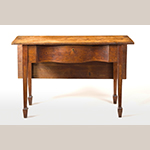
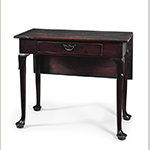
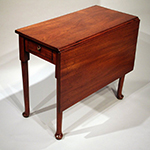
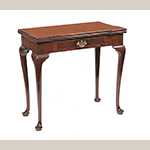
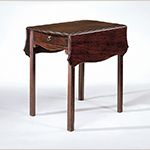
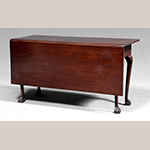
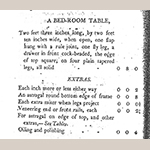
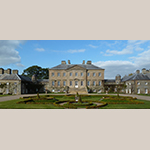
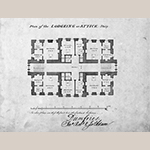
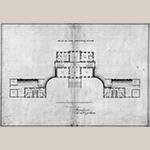
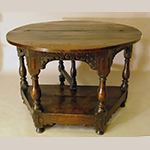
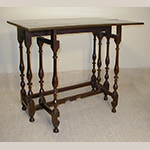
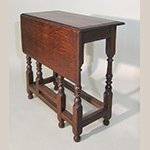
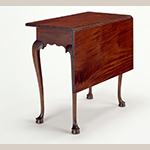
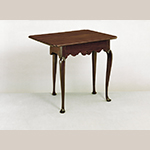
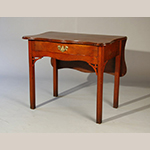
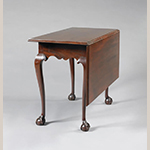
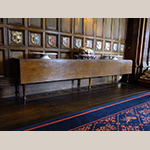
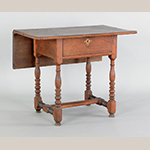
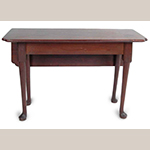
![Fig. 21: Bedroom table (or single-leaf table), ca. 1750, Eastern North Carolina. Mahogany and cherry; HOA: 29-5/8” (including 7/8” castor [replaced]), WOA: 36-7/8”, DOA: 17-1/2” (closed), 24-3/4” (open). Private collection, photograph courtesy Thomas R.J. Newbern and James R. Melchor.](https://www.mesdajournal.org/files/Davison_Fig_21_Thumb.jpg)
